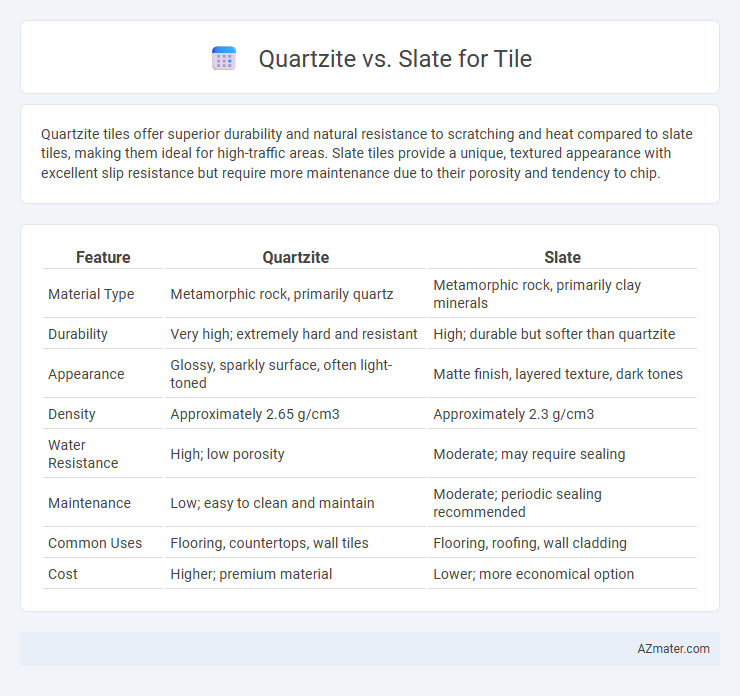Quartzite tiles offer superior durability and natural resistance to scratching and heat compared to slate tiles, making them ideal for high-traffic areas. Slate tiles provide a unique, textured appearance with excellent slip resistance but require more maintenance due to their porosity and tendency to chip.
Table of Comparison
| Feature | Quartzite | Slate |
|---|---|---|
| Material Type | Metamorphic rock, primarily quartz | Metamorphic rock, primarily clay minerals |
| Durability | Very high; extremely hard and resistant | High; durable but softer than quartzite |
| Appearance | Glossy, sparkly surface, often light-toned | Matte finish, layered texture, dark tones |
| Density | Approximately 2.65 g/cm3 | Approximately 2.3 g/cm3 |
| Water Resistance | High; low porosity | Moderate; may require sealing |
| Maintenance | Low; easy to clean and maintain | Moderate; periodic sealing recommended |
| Common Uses | Flooring, countertops, wall tiles | Flooring, roofing, wall cladding |
| Cost | Higher; premium material | Lower; more economical option |
Understanding Quartzite and Slate: Key Differences
Quartzite is a natural stone formed from sandstone subjected to intense heat and pressure, resulting in a durable, non-porous surface ideal for high-traffic tile applications. Slate, a metamorphic rock derived from shale, features a layered, foliated texture that offers slip resistance and a rustic appearance, but it is generally softer and more porous than quartzite. The key differences lie in quartzite's hardness, resistance to abrasion, and maintenance needs compared to slate's unique cleft surface, susceptibility to scratching, and requirement for sealing.
Appearance and Color Variations
Quartzite offers a natural, glassy appearance with a wide range of color variations including whites, greys, pinks, and blues, providing a vibrant and elegant finish. Slate features a more subdued, matte appearance with earthy tones such as greens, blacks, greys, and rusts, delivering a rustic and textured look. Both materials provide unique aesthetic qualities, but quartzite's brighter hues and reflective surface contrast with slate's deeper, natural color palette and rough texture.
Durability and Hardness Comparison
Quartzite exhibits exceptional durability and hardness, ranking around 7 on the Mohs scale, making it highly resistant to scratching and ideal for high-traffic flooring areas. Slate, though slightly softer with a hardness of 5.5 to 6, offers good durability but can be more prone to chipping and surface wear under heavy impact. Quartzite's dense, crystalline structure contributes to superior resistance against staining and etching compared to the more porous and layered composition of slate tiles.
Water and Stain Resistance
Quartzite tiles exhibit superior water and stain resistance compared to slate due to their denser, non-porous composition, making them ideal for high-moisture areas. Slate's natural cleft surface is more porous and requires regular sealing to prevent water absorption and staining, which can compromise durability over time. For long-lasting performance in wet environments, quartzite offers a more resilient and low-maintenance choice than slate.
Maintenance Requirements
Quartzite tiles require minimal maintenance due to their hardness and resistance to scratches and stains, making them ideal for high-traffic areas. Slate tiles, while durable, need regular sealing and more frequent cleaning to prevent moisture absorption and surface damage. Proper care for slate involves routine sealing every 1 to 2 years to maintain its appearance and durability, whereas quartzite demands less frequent maintenance, primarily occasional cleaning with pH-neutral products.
Installation Process and Challenges
Quartzite tile installation requires careful handling due to its hardness and density, often necessitating diamond-tipped cutting tools to achieve precise cuts without chipping; its weight demands a strong subfloor and specialized adhesives for secure bonding. Slate, being softer and more porous, is easier to cut with standard tile saws but requires thorough sealing to prevent staining and water damage, increasing maintenance considerations during installation. Both materials pose challenges: quartzite's rigid structure can lead to cracking if improperly installed, while slate's natural cleft surface demands skilled leveling to avoid uneven tiles.
Cost Comparison: Quartzite vs Slate
Quartzite tiles generally cost between $5 and $15 per square foot, while slate tiles range from $3 to $10 per square foot, making slate the more budget-friendly option. Installation expenses can vary but typically align closely with material costs, with quartzite requiring specialized tools due to its hardness, potentially increasing labor charges. Maintenance costs for quartzite tend to be lower than slate since quartzite is less porous and more resistant to staining, reducing the need for frequent sealing.
Best Applications for Quartzite Tiles
Quartzite tiles excel in high-traffic areas such as kitchens, bathrooms, and entryways due to their superior hardness, abrasion resistance, and natural slip resistance. Their dense composition makes them highly durable against scratches, stains, and moisture, ideal for both indoor and outdoor applications including countertops, flooring, and wall cladding. Quartzite's ability to withstand heavy use without losing its polished appearance positions it as a premier choice for commercial and residential tile installations requiring long-lasting performance.
Best Uses for Slate Tiles
Slate tiles offer exceptional durability and natural slip resistance, making them ideal for high-traffic areas such as kitchens, bathrooms, and entryways. Their moisture resistance and low porosity also make slate perfect for outdoor applications including patios and walkways. Slate's unique texture and rich color variations enhance aesthetic appeal in both rustic and contemporary interior designs.
Choosing Between Quartzite and Slate: Which is Right for You?
Quartzite offers exceptional hardness and scratch resistance, making it ideal for high-traffic areas and kitchens, while slate provides natural slip resistance and a rustic, textured appearance suitable for bathrooms and outdoor spaces. Both materials require sealing to prevent staining, but slate tends to be more porous and may need more frequent maintenance. When choosing between quartzite and slate for tile, consider your priorities for durability, aesthetic style, and maintenance commitment to select the material that best suits your lifestyle and design goals.

Infographic: Quartzite vs Slate for Tile
 azmater.com
azmater.com